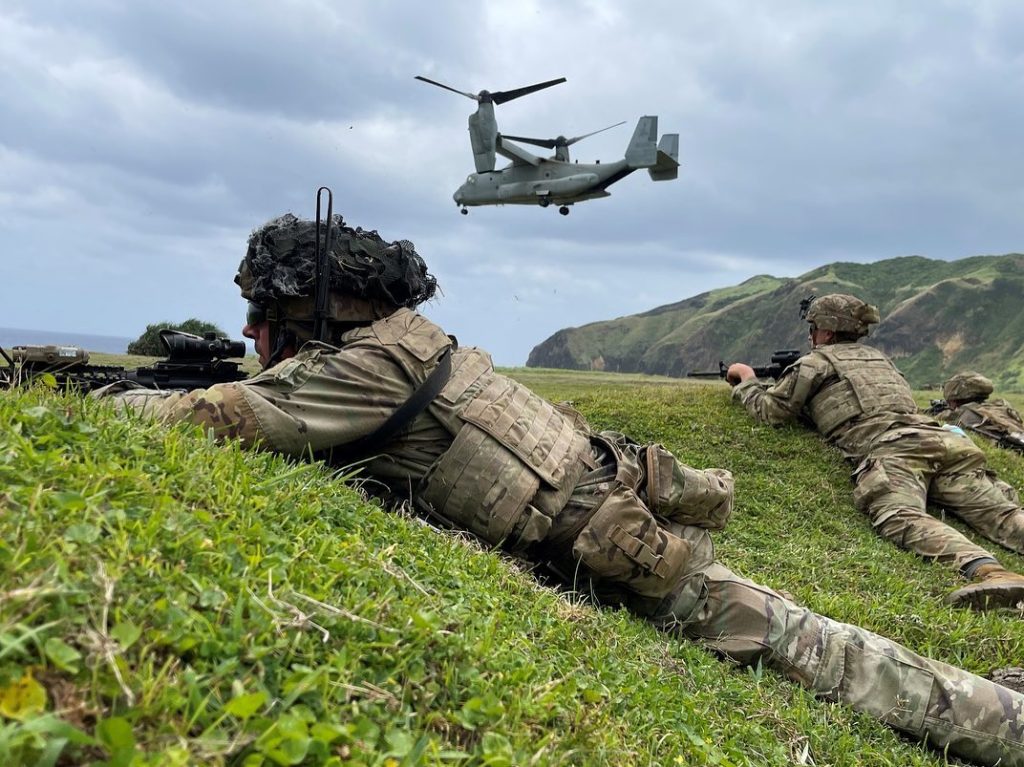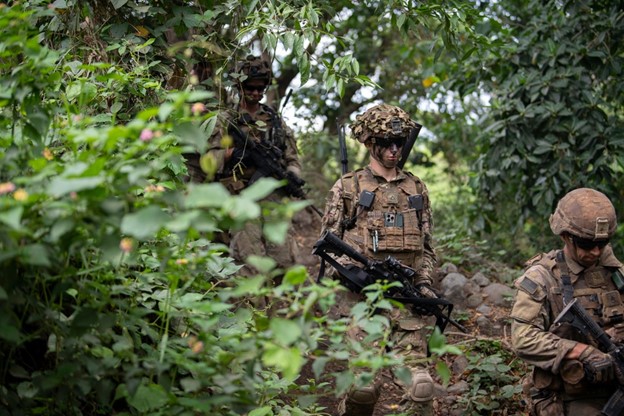
RADIO JUNGLE: A Soldier with the 25th ID conducts low-cost, secure but unclassified-encrypted radio experimentation during a jungle situational training exercise in support of Operation Tiger Balm, held in Hawaii as part of Operation Pathways. The Army is considering radio options that are sufficient for platoon and below and is collecting Soldier feedback on several candidate radios to complete market research. (Photo courtesy of Singapore Army)
Operation Pathways lead to interoperable multinational communications
From Hawaii to Southeast Asia to Australia, the multinational exercise Operation Pathways is providing far-reaching opportunities to strengthen joint capabilities while preparing for emerging near-peer threats in the Pacific area of operations.
The annual exercise is the ideal backdrop to assist the Army with its current path to make the division the unit of action as part of the Army of 2030, which will reduce complexity at brigade and below echelons and free up maneuver forces to operate unencumbered and conduct on the move operations. As with all exercises and ongoing operations, the Army will use Soldier feedback garnered from Operation Pathways to also inform the network of 2030 design.
The 25th Infantry Division (25th ID) at Schofield Barracks, Hawaii, is serving as the division unit of action for Operation Pathways and is operating the Integrated Tactical Network (ITN) suite of capabilities as the network transport for the event.
Since its introduction to Soldiers in 2019, the ITN has been providing secure but unclassified and encrypted mobile network communications that increase communications mobility, flexibility and resilience. The ITN is comprised of both military and commercial technologies and includes several varieties of software-defined tactical radios, commercial phone technology and small satellite terminals. ITN radios deliver applications through the Nett Warrior user device to consolidate the air, ground and fires pictures into a single common operating picture.

LAND OR SEA: Soldiers with the 25th ID, Marines from the 3d Marine Littoral Regiment and soldiers of the Armed Forces of the Philippines secure an objective on Basco Island, Philippines as part of their amphibious air assault training exercise during Balikatan, part of the Operation Pathways exercises, April 23, 2023. The 25th ID is serving as the exercise’s division unit of action and using the Integrated Tactical Network to conduct operations all the way down to the edge. (Photo by Maj. Jeffrey Tolbert)
In a multinational exercise, it is critical to ease communications restrictions among coalition partners while still protecting sensitive information, which is why the Army is considering operationalizing a secure but unclassified-encrypted (SBU-E) environment.
“The SBU-E addresses the need to cut the line between having a secret, Type 1 encrypted network to a network that is still encrypted, still very safe, but will allow us to better interoperate with our mission partners,” said Col. Shermoan Daiyaan, Project Manager for Tactical Radios. “In the Pacific and EUCOM [European Command] theaters, this is absolutely vital because we will never fight alone.”
PM TR, under Program Executive Office for Command, Control, Communications-Tactical, is the program of record for the ITN suite of capabilities.
Operating SBU-E allows for data transmission from Soldiers at the edge with radios up to division headquarters, even in a disconnected, intermittent, limited environment because the ITN allows for communications to transmit on multiple commercial pathways—critical for Soldiers’ primary, alternate, contingency and emergency plan.
The 25th ID is also employing cross-domain solutions to exchange sensitive data between various levels of classifications. This is a proof of concept that has been operationalized by the 25th ID, allowing the division to pull SBU-E position location information from subordinate units in the Philippines throughout Salaknib, the Philippine Army-led, U.S. Army Pacific sponsored bilateral exercise portion.
Furthermore, while experimenting with the Tactical Cross Domain Solution during the exercise, engineers with PM TR developed an innovative solution that allowed for a two-way common operating picture versus the one-way common operating picture currently employed by the 2nd Brigade Combat Team of 25th ID. With this solution, the higher headquarters within the exercise, I Corps and U.S. Army Pacific, have visibility of the 25th ID headquarters common operating picture down to the tactical edge.
In addition to division as unit of action experimentation, Operation Pathways is helping the Army inform its fiscal year 2025 network designs. One of the most exciting experiments during the exercise featured a high frequency (HF) ground radio, which in March achieved the longest waveform “shot” achieved to-date across the Pacific.

FORWARD MARCH: Soldiers with the 25 ID conduct a jungle patrol during a combined arms field training exercise at Colonel Ernesto Ravina Air Base, Philippines as part of Balikatan 23 on April 13, 2023. The 25th ID is using the ITN to conduct operations all the way down to the edge, which is providing feedback to the Army as it prepares for the Army of 2030 and beyond. (Photo by Maj. Jeffrey Tolbert)
“The 25th ID successfully completed an approximately 8,000 kilometer HF shot by employing the PRC-160 HF Manpack radio with the LDD [Last Ditch Data] waveform to communicate from Fort Magsaysay, Philippines to the division main at Schofield Barracks,” Daiyaan said. “That’s well beyond any HF shot with this radio that we are aware of.”
Given the success of this waveform shot, the PM TR team plans to attempt further shots from the U.S. to the Philippines.
The Tiger Balm portion of Operation Pathways, held in Hawaii, provided another perfect scenario for the Army to exercise critical radio technologies by preparing tactical units to execute small unit tactics in a controlled environment. During their jungle situational training exercise, Soldiers with the C Troop, 2nd Squadron, 14th Cavalry Regiment, 2nd Infantry Brigade Combat Team, 25th ID exercised candidate low cost, single channel radios that operate over SBU-E. The radios are part of a current market research effort to identify options for radios that facilitate command and control operations at the platoon level and below and provide significant cost savings to the Army.
“We have a million-person Army, which means we need to make sure we have the right mix and quantities of radios at echelon,” Daiyaan said. “Some of those radios have different use cases, but we’re asking ourselves, ‘is that correct for the next fight’? Many of those were built for a fight that may have passed.”
Experiments for the culminating Operations Pathway biennial exercise Talisman Sabre, held in Australia this summer, will further refine the experiments conducted in the exercises leading up to it. The entire Operation Pathways exercise will help inform the first fielding for the ITN at the division level, beginning with the 82nd Airborne Division, followed by the 101st Airborne Division (Air Assault).
Preparing to conduct operations across a noncontiguous archipelagic operating environment in a multinational environment will require secure and robust communications up and down echelons.
“Soldier feedback will continue to drive everything we are doing to meet division as unit of action requirements,” Daiyaan said. “Leveraging all of the data we’re collecting on the SBU-E network, our cross-domain solutions, radios and various resilient waveforms is keeping the momentum strong to meet any challenges we may face as we drive towards the Army of 2030.”
—MAJ. RICHARD RICKETTS AND KATHRYN BAILEY







